Layers, fragments, projects, and taxonomy in Content Studio
How GK, the leading technical entrepreneur and service partner in Scandinavia uses the Enonic system.

How GK, the leading technical entrepreneur and service partner in Scandinavia uses the Enonic system.
GK is Scandinavia's leading technical contractor and service partner. The company provides environmental and energy services in buildings across three countries, with 48 offices in Norway, 28 in Sweden, and 8 in Denmark. GK aims to have the construction industry's strongest brand and be the most attractive employer.
In 2020, GK implemented a new strategy, which included strategic choices such as a new visual identity and changed brand architecture. They developed a channel and content strategy, a communication strategy with style and tone, and new websites. Additionally, GK established new career pages and an MVP for employer branding work.
Maiken Danielsen Mandal works as a communications advisor at GK and is responsible for digital channels. She recently gave a presentation on how GK uses Content Studio, particularly layers, fragments, projects, and taxonomy, and how they utilize Enonic functionality when publishing on three websites—in three languages.
See the presentation (in Norwegian):

The strategy platform for GK's websites consists of a UX guide and a channel and content strategy. This strategy describes what kind of content should be published, which target groups should be reached, and where the content should be distributed. The goal is to work smarter, more efficiently, and more targeted with GK's digital channels.
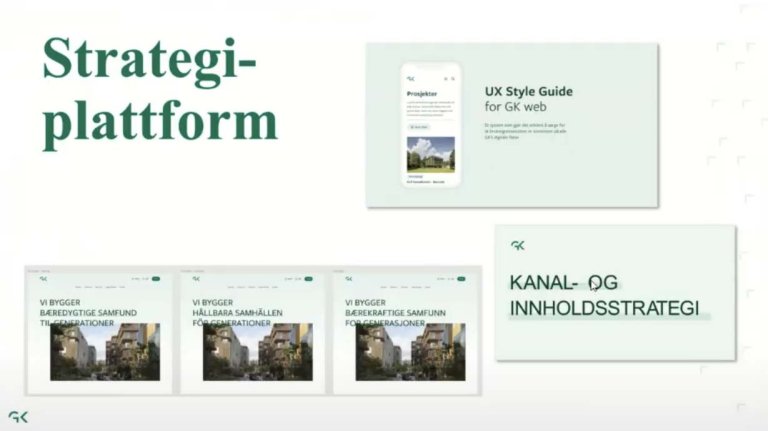
The websites serve as the hub in this digital ecosystem. The main tasks on the websites are to showcase projects that GK are working on, present references, expertise, and services, and make it easy to contact the company. The websites should also display job vacancies.
The website's primary role is to build awareness and knowledge about GK's expertise and services, function as a content hub, increase traffic, and indirectly contribute to sales and conversion.
GK have an editorial charter that all editors adhere to. The mission is to build sustainable communities for generations. GK have a brand role and values that underpin everything they do, aiming to lead as a climate role model. This is also the company's vision.
Content pillars are important for GK when publishing. They have a checklist to ensure good SEO, timeliness criteria in production, and that the content aligns with the goals and KPIs defined in the channel and content strategy. It is important for GK to be clear about what the user needs and wants and to have good collections. Relevant hashtags linked to the website's taxonomy are also part of the publishing strategy.
GK are a group with headquarters in Norway, also operating in Sweden and Denmark. Norway is the largest unit with about 2,000 employees, Sweden has about 700, and Denmark just over 300. At the group level, GK has three editors, two editors in Norway, one in Sweden, and several in Denmark, where an agency assists.
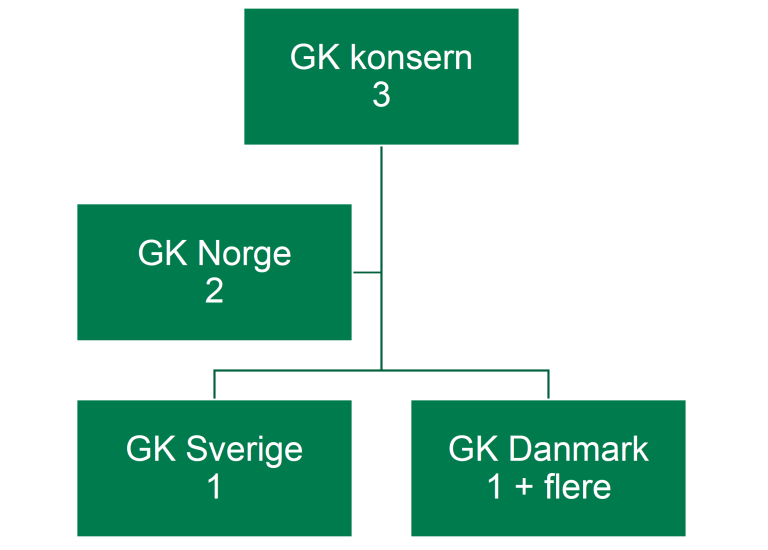
Editors at the group level, as well as those in Norway, Sweden, and Denmark, work according to the same principles to ensure consistency. The goal is to develop and build solutions that make it easy for all editors to work in the same way, regardless of the country.
GK's website is set up with Enonic's layer system, with Norway at the top. By using layers, content can be inherited from a parent page. This content can then be localized, renamed, organized on subpages, or archived. By using layers, GK can achieve a uniform structure on the sites in Norway, Sweden, and Denmark, providing better control over the page structure and significantly simplifying the publishing job.
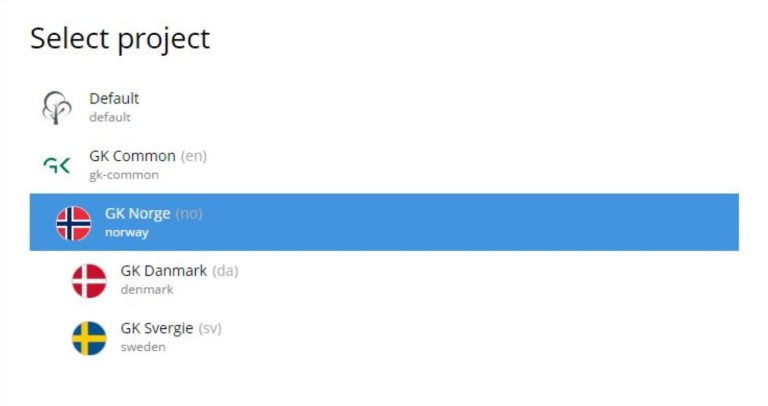
At the top, GK has "GK common," the company's Digital Asset Management (DAM). Next comes Norway, with Denmark and Sweden underneath, inheriting content from Norway. This is shown in the test environment, where Denmark has inherited a case from Norway. All links, connections, images, and files follow along, and editors can translate and adapt the content locally.
For example, an image published in Norway is synced to Denmark and Sweden, and the caption and image information edited to the correct language. The taxonomy also has slightly different naming to ensure correct language use, but all content components are preserved when inherited downwards.
GK actively uses taxonomy to keep the pages updated, as well as to ensure they communicate with each other. This involves a folder with tags covering topics such as expertise, services, building type, and county. Within topics, GK has several content categories, such as circular economy, indoor climate, and smart buildings, where much of the content is produced.
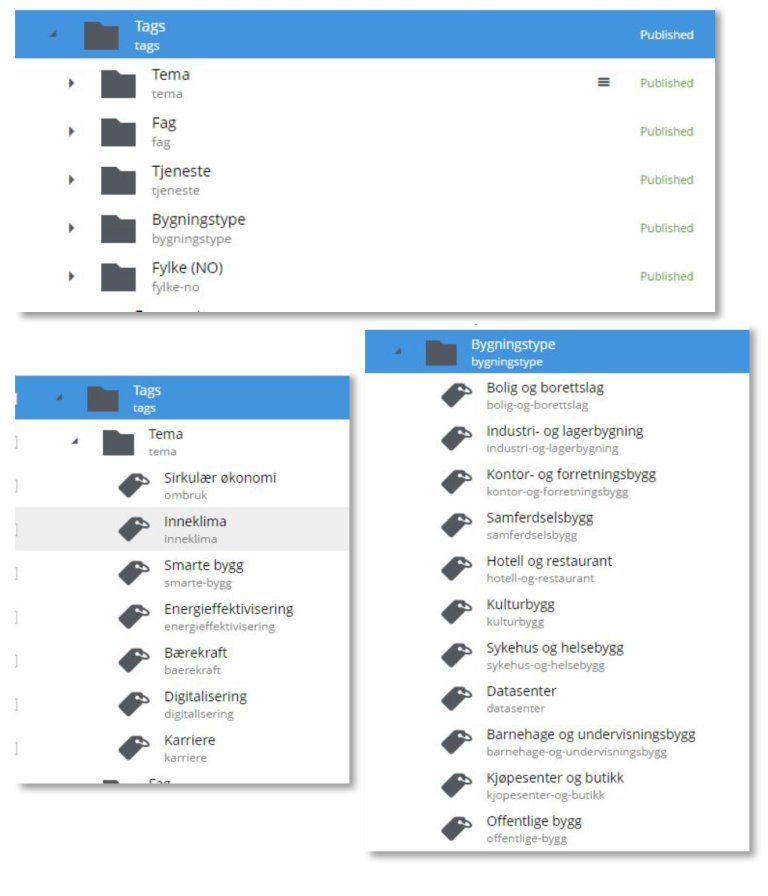
Building type is an important category for the reference database, allowing users to filter references based on building type, service, and location. This is also implemented on the "Contact Us" pages, where users can find the right service at the right local office.
Tags are also used to categorize content types, making updating easier. For example, the career pages have their own content template that extracts all articles tagged with "career". On topic pages, tags are actively used to highlight relevant articles, such as articles on energy efficiency. This makes it possible to showcase specific content in a structured and efficient manner.
GK use Enonic's project feature as part of its Digital Asset Management (DAM) system. Content such as images and documents is uploaded at the top level, making it available to everyone. For example, an image of a woman can be uploaded, and this content will be available to all editors.
Sustainability reports and other important documents are published as files at the top level and can be inherited down to all countries. This means that the documents become available in Norway, Sweden, and Denmark without the need for separate uploads in each country.
When content is retrieved to a lower level, such as a page at the Danish level, it becomes immediately available. Editors can then edit and localize the content, for example by changing captions and other information to the correct language. This results in a local version of the same image or document, adapted to the specific language and context.
This method ensures consistency in content across countries, while also providing the flexibility to adapt and translate content as needed.
GK use Enonic's fragment functionality frequently to ensure consistent and efficient reuse and publishing of campaigns and other content. An example of this is a recent campaign called "Good Colleagues with Superpowers." The goal is to make this campaign visible on as many career pages as possible.
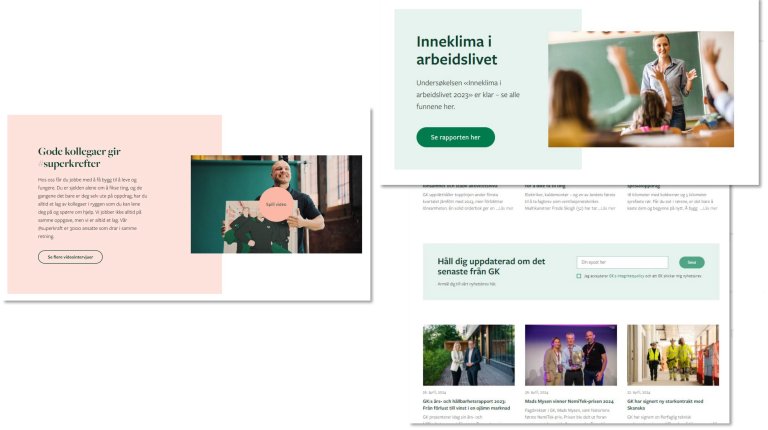
To ensure a cohesive presence of the campaign pages, fragments are set up so that all relevant entries to the campaign are included. This makes it easy to manage campaigns, as the fragments can be placed on multiple pages without the need for individual updates for each page.
Fragments are also used for:
By using fragments, GK can retrieve content packages and place them easily, without having to remember all the details each time. This simplifies the publishing process and ensures that all relevant content is included.
GK collaborate with 99x Consulting and have no internal developers. To ensure that all development is intuitive and accessible to everyone, GK have created comprehensive documentation.

The documentation, available in Google Docs, provides an overview of:
The documentation is made to ensure that the knowledge of developed solutions does not reside with one or a few people. This makes it easier for new editors to get acquainted with the components adapted to GK and practice using them. The documentation helps all editors work efficiently and independently, regardless of technical background.
GK have several projects where they use Enonic as a headless CMS solution.
For instance, they have set up an external onboarding process with login. This consists of a simple information page used for preboarding. Here, new employees can get to know GK before picking up their key card. The information page includes:
This solution allows new employees to get to know the company in a simple and structured way before starting the job.
GK developed a guide for the Enova energy subsidy scheme, which became relevant when electricity prices rose sharply during the energy crisis. The guide is an online tool that companies can use to calculate how much energy support they can get through the subsidy scheme.
The guide consists of a series of questions that help companies determine if they qualify for support:
The guide also includes features for collecting contact information so that GK can follow up with companies that qualify for support.
The guide provides companies with a simple and efficient way to find out if they qualify for energy support. It helps them understand the criteria and process, ensuring they get the information they need to apply for support.
GK are testing a new app for automatic translation, developed to ease the work with content in three languages. The app is currently in the testing phase and has not yet been put into production.

The app has been tested in the test environment with an article that was first written and published in Norwegian. Test results show that the translation works quite well, although some adjustments are still needed.
This automatic translation app is expected to become a valuable tool for GK, especially for those working with content in multiple languages. The app will:
GK look forward to testing the app further and implementing it in production to improve workflow and efficiency in content publishing.
GK are using the Gobi App on their career pages. Gobi offers video snippets in portrait format, similar to the story format on Snapchat and Instagram. This makes the content more engaging and mobile-friendly.
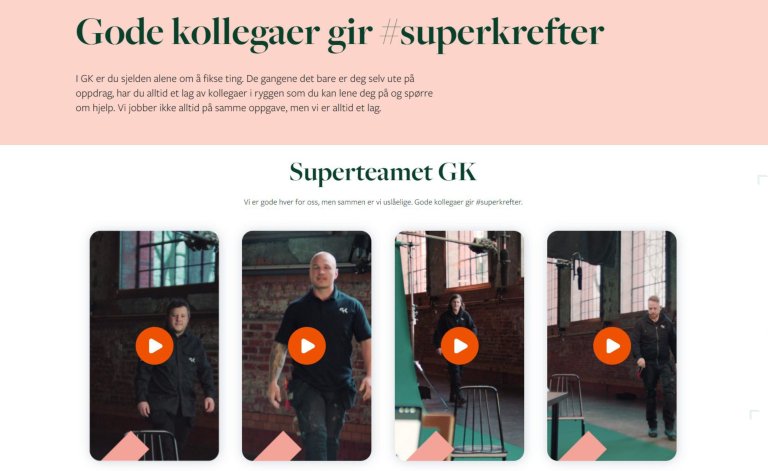
A new campaign has recently been launched with a mobile-first approach, as most visitors to the career pages come from mobile. The campaign includes video interviews with employees presented as superheroes, still in portrait format using Gobi. Users can scroll through the various video segments, providing an engaging experience.
GK have also:
This integration makes the career pages more interactive and engaging, while simplifying navigation between different content types and platforms.
Question: If you add content to a project at the root level, can you then publish it in all layers without having to publish it again in each layer?
Answer: You must publish the content again in each layer to display it.
Question: Will the content be updated in the local layers if you make changes to the project at the root level?
Answer: Changes at the root level do not automatically update the content in the local layers. To update the content, you must upload a new file at the local level. If you haven't made changes to the content, however, you can publish it directly.
Get some more insights: